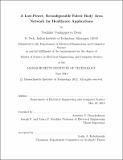A low power, reconfigurable fabric body area network for healthcare applications
Author(s)
Desai, Nachiket Venkappayya
DownloadFull printable version (9.790Mb)
Other Contributors
Massachusetts Institute of Technology. Dept. of Electrical Engineering and Computer Science.
Advisor
Anantha P. Chandrakasan.
Terms of use
Metadata
Show full item recordAbstract
Body Area Networks (BANs) are gaining prominence for their capability to revolutionize medical monitoring, diagnosis and treatment. This thesis describes a BAN that uses conductive fabrics (e-textiles) worn by the user to act as a power distribution and data communication network to sensors on the user's body. The network is controlled by a central hub in the form of a Base Station, which can either be a standalone device or can be embedded inside one of the user's portable electronic devices like a cellphone. Specifications for a Physical (PHY) layer and a Medium Access Control (MAC) layer have been developed that make use of the asymmetric energy budgets between the base station and sensor nodes in the network. The PHY layer has been designed to be suitable for the unique needs of such a BAN, namely easy reconfigurability, fault-tolerance and efficient energy and data transfer at low power levels. This is achieved by a mechanism for dividing the network into groups of sensors. The co-designed MAC layer is capable of supporting a wide variety of sensors with different data rate and network access requirements, ranging from EEG monitors to temperature sensors. Circuits have been designed at both ends of the network to transmit, receive and store power and data in appropriate frequency bands. Digital circuits have been designed to implement the MAC protocols. The base station and sensor nodes have been implemented in standard 180nm 1P6M CMOS process, and occupy an area 4.8mm2 and 3.6mm2 respectively. The base station has a minimum power consumption of 2.86mW, which includes the power transmitter, modulation and demodulation circuitry. The sensor nodes can recover up to 33.6paW power to supply to the biomedical signal acquisition circuitry with peak transfer efficiency of 1.2%.
Description
Thesis (S.M.)--Massachusetts Institute of Technology, Dept. of Electrical Engineering and Computer Science, 2012. Cataloged from PDF version of thesis. Includes bibliographical references (p. 105-110).
Date issued
2012Department
Massachusetts Institute of Technology. Department of Electrical Engineering and Computer SciencePublisher
Massachusetts Institute of Technology
Keywords
Electrical Engineering and Computer Science.